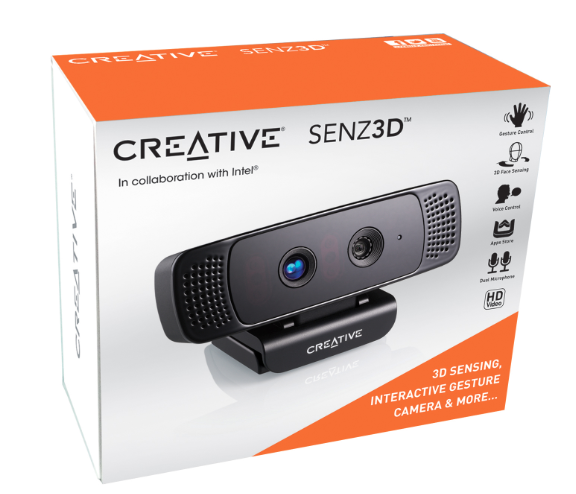Intel Unveils Creative Senz3D Camera to Redefine Perceptual Computing

TAIPEI, TAIWAN-- The theme of this year’s Computex seems to be reimagining the way people interact with PCs, and the Creative Senz3D camera does just that. Intel and Creative Labs have collaborated to unveil the Senz3D motion-tracking webcam, which uses two built-in camera lenses instead of one to create a more accurate depth of field.
The Creative Senz3D does more than simply detect movement. It’s designed to generate a skeletal map of your hand to recognize even the slightest gestures and recognize your hand. It’s different from devices such as Microsoft’s Kinect in that it’s built to track close-range hand and facial movement rather than your entire body. Unlike the Leap Motion controller, CreativeSenz 3D allows you to do more than navigate your PC using motion controls—it lets you to interact on a deeper, three-dimensional level.
For example, the device’s dual-camera design lets you actually reach toward the TV to grab a moving object, such as a bouncing ball for instance. Users can interact with a 3D character by performing gestures forward and backward, rather than just moving their hand up, down, and to the left or right. Intel and Creative Labs have worked on several apps for the Senz3D camera that include games, communication, voice enabled search and even security applications. There are currently about seven apps that are available for the Creative Senz3D, but Intel promises that number is growing.
MORE: 20 Sexiest Laptops of All Time
In addition to developing new gesture-optimized titles for the Creative Senz3D, a new version of Portal 2 that utilizes these controls will launch for free with the webcam. In our demo, we saw an Intel representative lift and toss Companion Cubes by simply raising his hand and performing a throwing motion, just like one would throw an actual object in real time.
The FastAccess app creates a three-dimensional map of your face for accurate recognition when unlocking your computer. The Creative Senz3D’s dual-cam technology creates a 3D map of your face, meaning it can detect depth, movement and facial characteristics. This ensures that the camera will only recognize your face, rather than a photo or a video of you.
Intel showcased how the Creative Senz3D camera can be integrated into Skype with its Personify Chat plug-in, which essentially turns your backdrop into a personal green screen. You can swap out your backdrop for one of the plug-in’s pre-loaded skins or a photo of your choosing.
Stay in the know with Laptop Mag
Get our in-depth reviews, helpful tips, great deals, and the biggest news stories delivered to your inbox.
The Dragon Assistant is touted as a voice search tool, but it functions more as a personalized assistant that recognizes your specific voice tone and speech. When launching Dragon Assistant for the first time, the app prompts you to read a few lines of text so it can remember the nuances of your speech. During our demo, Intel showcased how Dragon can be used to search the Web or perform functions on the desktop. For example, telling Dragon to “Play rock music” will automatically launch a rock song from your music library.
Devices such as the Creative Senz3D illustrate just how fast 3D technology is evolving. Like Leap Motion, which struck a deal with HP to have its motion webcam built in to select devices, Creative Senz3D will also eventually come integrated in laptops and tablets. Intel and Creative Labs have yet to specify which devices will come loaded with the Senz3D or when we can expect this integration, but the emergence of such devices hints that motion control could eventually become as prominent as the touch screen.

